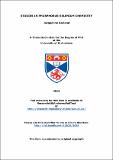Files in this item
Studies in phosphorus-selenium chemistry
Item metadata
| dc.contributor.advisor | Woollins, J. D. (J. Derek) | |
| dc.contributor.advisor | Hey-Hawkins, E. | |
| dc.contributor.author | Garland, Jacqueline M. | |
| dc.coverage.spatial | 269 | en_US |
| dc.date.accessioned | 2013-06-13T10:37:16Z | |
| dc.date.available | 2013-06-13T10:37:16Z | |
| dc.date.issued | 2013-06-26 | |
| dc.identifier | uk.bl.ethos.574795 | |
| dc.identifier.uri | https://hdl.handle.net/10023/3688 | |
| dc.description.abstract | Phosphorus-selenium chemistry has seen a surge in development over the last five to ten years thanks to the optimisation of the synthesis of 2,4-diphenyl-1,3,2,4-diselenadiphosphetane-2,4-diselenide, Woollins’ Reagent. This selenium analogue of the well known Lawesson’s Reagent has proved itself to be a valuable asset to modern inorganic chemistry, providing a route to novel heterocycles, as well as acting as a selenation reagent with a wide range of functional groups. A series of new ammonium phenylphosphonamidodiselenoate ligands were synthesised via the reaction of Woollins’ Reagent with a range of amines. The products were obtained in high yields and could be used as ligands for the synthesis of novel metal complexes. The reaction of diisopropylamine N-isopropyl-P-phenylphosphonamidodiselenoate with nickel(II) acetate produces a dimeric structure, whilst the reaction with copper(II) acetate yields a beautiful cluster of the form Cu₆Se₃L₆. The phenylphosphonamidodiselenoate ligands were further reacted with a range of cis-Pt(PR₃)₂Cl₂ complexes to form a library of 20 novel compounds, which were studied by ³¹P{¹H}, ⁷⁷Se{¹H} and ¹⁹⁵Pt{¹H} NMR spectroscopy. The X-ray crystal structure of one of these compounds was obtained, which confirmed the atom connectivity and spatial arrangement of the complexes and the geometry around the platinum centre. During investigations into the above-mentioned platinum complexes, it was postulated that an increase in steric bulk of the phosphine ligands would aid crystallisation of the products. As such, trimesityl-, dimesitylphenyl- and mesityldiphenyl phosphine were synthesised and reacted with elemental sulfur and selenium and hydrogen peroxide, as well as Pt(cod)Cl₂ and K₂[PtCl₄], yielding nine new structures, all of which were characterised by X-ray crystallography, ³¹P{¹H}, ¹³C{¹H} and ¹H NMR spectroscopy. Finally Woollins’ Reagent was reacted directly with a selection of metal complexes, yielding some new insights into its reactivity with inorganic moieties, which has been relatively sparsely reported until now. | en_US |
| dc.language.iso | en | en_US |
| dc.publisher | University of St Andrews | |
| dc.subject | Phosphorus | en_US |
| dc.subject | Selenium | en_US |
| dc.subject | Inorganic | en_US |
| dc.subject | Transition metals | en_US |
| dc.subject | Woollins' reagent | en_US |
| dc.subject | Heterocycles | en_US |
| dc.subject.lcc | QD181.P1G2 | |
| dc.subject.lcsh | Phosphorus compounds | en_US |
| dc.subject.lcsh | Selenium compounds | en_US |
| dc.subject.lcsh | Ligands--Synthesis | en_US |
| dc.title | Studies in phosphorus-selenium chemistry | en_US |
| dc.type | Thesis | en_US |
| dc.type.qualificationlevel | Doctoral | en_US |
| dc.type.qualificationname | PhD Doctor of Philosophy | en_US |
| dc.publisher.institution | The University of St Andrews | en_US |
| dc.publisher.department | Universität Leipzig | en_US |
The following licence files are associated with this item:
This item appears in the following Collection(s)
Items in the St Andrews Research Repository are protected by copyright, with all rights reserved, unless otherwise indicated.

